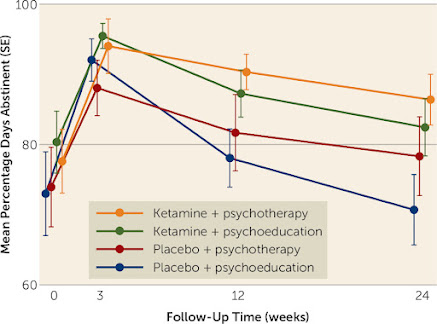Adjunctive Ketamine With Relapse Prevention–Based Psychological Therapy in the Treatment of Alcohol Use Disorder

Adjunctive Ketamine With Relapse Prevention–Based Psychological Therapy in the Treatment of Alcohol Use Disorder Published Online: 11 Jan 2022 https://doi.org/10.1176/appi.ajp.2021.21030277 Objective: Early evidence suggests that ketamine may be an effective treatment to sustain abstinence from alcohol. The authors investigated the safety and efficacy of ketamine compared with placebo in increasing abstinence in patients with alcohol use disorder. An additional aim was to pilot ketamine combined with mindfulness-based relapse prevention therapy compared with ketamine and alcohol education as a therapy control. Methods: In a double-blind placebo-controlled phase 2 clinical trial, 96 patients with severe alcohol use disorder were randomly assigned to one of four conditions: 1) three weekly ketamine infusions (0.8 mg/kg i.v. over 40 minutes) plus psychological therapy, 2) three saline infusions plus psychological therapy, 3) three ketamine infusions plus alcohol education, or 4) three sal

